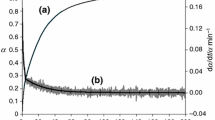Abstract
Purpose. The processes of dehydration, rehydration, and solidification of trehalose dihydrate were examined to simulate it in the drying and wetting states.
Methods. Techniques included differential scanning calorimetry (DSC), thermogravimetric analysis (TGA), and Fourier transform infrared (FT-IR) microspectroscopy combined with thermal analysis. Trehalose dihydrate was pressed on one KBr pellet (1KBr method) or sealed within two KBr pellets (2KBr method) for FT-IR measurement.
Results. On the DSC thermogram, the shoulder between 60°C and 80°C represented a transitional change because no weight loss occurred in this area of the TGA curve. The endothermic peak at 100°C represented dehydration of trehalose dihydrate to anhydrous trehalose; a 9.5% weight loss in the TGA curve occurred from 81°C. The thermal-dependent FT-IR spectra for trehalose dihydrate prepared by the 1KBr method changed markedly with temperature in the 1800-1500 cm−1 region during dehydration. IR peak intensity at 1687 cm−1 assigned to the bending vibrational mode of solid-like water declined with temperature and decreased sharply at 67°C. Another IR peak at 1640 cm−1 associated with the bending of liquid water increased at 67°C but disappeared at 79°C as a result of water evaporation. Both peaks for the sample prepared by the 2KBr method changed dramatically at 64°C; peak intensity at 1640 cm−1 remained constant above 64°C.
Conclusions. A new polymorphic transition of trehalose dihydrate was first evidenced at 64-67°C from both DSC curves and thermal-related FT-IR spectra. This transitional temperature reflected the thermal-dependent transformation from solid-like water to liquid water in the trehalose dihydrate structure during dehydration. During rehydration, trehalose anhydrate was rehydrated to the dihydrate, and liquid water in the dihydrate structure was again transformed to solid-like water. The polymorphic transition within this temperature range seems to correlate with the bioprotective effect of trehalose dihydrate in preserving protein stability.
Similar content being viewed by others
REFERENCES
M. Sola-Penna and J. R. Meyer-Fernandes. Stabilization against thermal inactivation promoted by sugars on enzyme structure and function: why is trehalose more effective than other sugars? Arch. Biochem. Biophys. 360:10-14 (1998).
J. L. Cleland, X. Lam, B. Kendrick, J. Yang, T. H. Yang, D. Overcashier, D. Brooks, C. Hsu, and J. F. Carpenter. A specific molar ratio of stabilizer to protein is required for storage stability of a lyophilized monoclonal antibody. J. Pharm. Sci. 90:310-321 (2001).
P. O. Souillac, H. R. Costantino, C. R. Middaugh, and J. H. Rytting. Investigation of protein/carbohydrate interactions in the dried state. 1. Calorimetric studies. J. Pharm. Sci. 91:206-216 (2002).
J. H. Crowe, L. M. Crowe, A. E. Oliver, N. Tsvetkova, W. Wolkers, and F. Tablin. The trehalose myth revisited: introduction to a symposium on stabilization of cells in the dry state. Cryobiology 43:89-105 (2001).
S. B. Leslie, E. Israeli, B. Lighthart, J. H. Crowe, and L. M. Crowe. Trehalose and sucrose protect both membranes and proteins in intact bacteria during drying. Appl. Environ. Microbiol. 61:3592-3597 (1995).
F. Franks. Long-term stabilization of biologicals. Biotechnology 12:38-42 (1991).
J. H. Crowe, J. F. Carpenter, and L. M. Crowe. The role of vitrification in anhydrobiosis. Annu. Rev. Physiol. 60:71-103 (1998).
A. M. Gil, P. S. Belton, and V. Felix. Spectroscopic studies of solid α-α trehalose. Spectrochim. Acta 52A:1649-1659 (1996).
F. Sussich, R. Urbani, F. Princivalle, and A. Cesaro. Polymorphic amorphous and crystalline forms of trehalose. J. Am. Chem. Soc. 120:7893-7899 (1998).
L. S. Taylor and P. York. Characterization of the phase transitions of trehalose dihydrate on heating and subsequent dehydration. J. Pharm. Sci. 87:347-355 (1998).
C. Macdonald and G. P. Johari. Glass-softing of trehalose and calorimetric transformations in its liquid state. J. Mol. Struct. 523:119-132 (2000).
F. Sussich, S. Bortoluzzi, and A. Cesaro. Trehalose dehydration under confined conditions. Thermochim. Acta 391:137-150 (2002).
H. Nagase, T. Endo, H. Ueda, and M. Nakagaki. An anhydrous polymorphic form of trehalose. Carbohydr. Res. 337:167-173 (2002).
K. Akao, Y. Okubo, N. Asakawa, Y. Inoue, and M. Sakurai. Infrared spectroscopic study on the properties of the anhydrous form II of trehalose. Implications for the functional mechanism of trehalose as a biostabilizer. Carbohydr. Res. 334:233-241 (2001).
J. N. de Wit and G. A. Swinkels. A differential scanning calorimetric study of the thermal denaturation of bovine beta-lactoglobulin: Thermal behaviour at temperatures up to 100 degrees C. Biochim. Biophys. Acta 624:40-50 (1980).
V. Vega-Warner and D. M. Smith. Denaturation and aggregation of myosin from two bovine muscle types. J. Agric. Food Chem. 49:906-912 (2001).
E. Cardellini, S. Cinelli, G. L. Gianfranceschi, G. Onori, A. Santucci, and L. Urbanelli. Differential scanning calorimetry of chromatin at different levels of condensation. Mol. Biol. Rep. 27:175-180 (2000).
S. L. Wang, S. Y. Lin, T. F. Chen, and C. H. Chuang. Solid-state trans-cis isomerization of captopril determined by thermal Fourier transform infrared (FT-IR) microspectroscopy. J. Pharm. Sci. 90:1034-1039 (2001).
E. Pretsch, J. Seibl, and W. Simon. (eds.), Tables of Spectral Data for Structure Determination of Organic Compounds, 2nd ed. Springer-Verlag, Berlin, 1989, pp. I15-I280.
J. P. Devlin. Vibrational modes of amorphous ice: bending mode frequencies for isotopically decoupled H2O and HOD at 90K. J. Mol. Struc. 224:33-48 (1990).
K. Akao, Y. Okubo, T. Ikeda, Y. Inoue, M. Sakurai. Infrared spectroscopic study on the structural property of a trehalose-water complex. Chem. Lett. 759-760 (1998)
P. A. Giguere. The bifurcated hydrogen-bond model of water and amorphous ice. J. Chem. Phys. 87:4835-4839 (1987).
Author information
Authors and Affiliations
Corresponding author
Rights and permissions
About this article
Cite this article
Lin, SY., Chien, JL. In Vitro Simulation of Solid-Solid Dehydration, Rehydration, and Solidification of Trehalose Dihydrate Using Thermal and Vibrational Spectroscopic Techniques. Pharm Res 20, 1926–1931 (2003). https://doi.org/10.1023/B:PHAM.0000008038.38378.d6
Issue Date:
DOI: https://doi.org/10.1023/B:PHAM.0000008038.38378.d6




